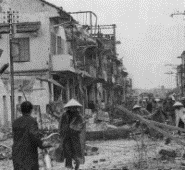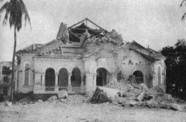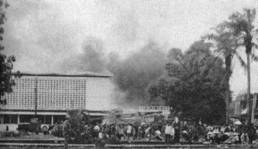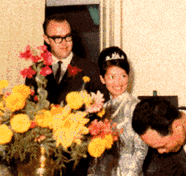by J.R. Bullington
Foreign Service National employees, the locally hired staff at U.S. diplomatic and consular posts, share many of the same challenges and dangers as their American colleagues. Particularly in wartime situations, their service to the United States can endanger their lives. That’s the case today in Iraq and Afghanistan, just as it was four decades ago in Vietnam.
In going through some old personal papers, I came across the handwritten draft of a memorandum I wrote on February 16, 1968, in Danang, describing the experiences during the Tet Offensive of my fiancée (now my wife) Tuy-Cam, who was then an FSN at the consulate general in Danang and had previously served at the consulate in Hué and the embassy in Saigon. I had previously served in both Hué and Saigon, and was at that time working in the pacification (counterinsurgency) program (known as CORDS — Civil Operations and Revolutionary Development Support) in Quang Tri, the northernmost province of South Vietnam. Both Tuy-Cam and I had gone to Hué, her hometown, for the Tet holiday and were trapped there when North Vietnamese forces overran the city on the night of January 30-31. The subsequent battle, in which American and South Vietnamese forces retook the city in bitter house-to-house fighting, was one of the fiercest and most prolonged of the Vietnam War, with high casualties among both combatants and civilian residents of the city. I was rescued by U.S. Marines after nine days behind the enemy lines disguised as a French priest, and I was able to find Tuy-Cam and bring her to Danang on February 14. (My story is at: www.unc.edu/depts/diplomat/AD_Issues/ amdipl_8/bullington_tet.html.)
During the occupation of Hué, the communist forces executed some 3000 Vietnamese who worked for the U.S. and South Vietnamese governments or who were otherwise considered enemies (out of a total Hué population of about 100,000), as well as several Americans and other foreigners. We did not know the extent of this atrocity at the time I wrote the memorandum, but the bodies were found in mass graves after the city was re-taken by U.S. and South Vietnamese forces. Both Tuy-Cam and I narrowly escaped this fate.
The memorandum was addressed to Ambassador Barney Koren, who was concurrently consul general and the deputy for CORDS at Third Marine Amphibious Force (III MAF) headquarters. It was designed to provide information and insight on what was happening in Hué during the North Vietnamese occupation, which continued in parts of the city until February 27. In transcribing it, I have added some explanatory material in brackets for terms that may not be clear to contemporary readers, and I have eliminated a few names of people who are still living in Vietnam. – J. R. Bullington, Editor.
TO: DFC III MAF – Ambassador Koren
FROM: J. R. Bullington
SUBJECT: Experiences of Tuy-Cam in Hué
Following are the experiences of my fiancée, Tuy-Cam, during the enemy occupation of Hué for the period she was there, January 31-February 14, together with some related information she learned.
When the attack began the early morning of January 31, Tuy-Cam was in her family residence, along with several other members of her family, including her mother, five sisters, and three brothers. The two eldest brothers are both RVNAF [Republic of Vietnam, i.e. South Vietnam, Armed Forces] officers.
The first time the family saw enemy forces was about 0300, when a large number of troops dressed in camouflage uniforms, similar to those worn by ARVN [Army of the Republic of Vietnam, i.e. South Vietnamese regular army] airborne troops or PFF [South Vietnamese Police Field Forces], were observed running down the railroad track to the rear of the house. Later, Tuy-Cam learned that VC/NVA [Viet Cong and/or North Vietnamese Army] troops had come about 0200 to the house of a refugee family behind her house and had arrested two men of this family. Also later, an NVA soldier told Tuy-Cam that his unit had moved in from the jungle [mountainous area west of Hué] to Hué that night in seven hours, running most of the way, and that they were all exhausted when they arrived.
At about 0630, a group of NVA came to the house. Previously, the two eldest brothers had hidden in the attic. Four of the NVA banged on the door with their rifle butts and demanded and were given entrance into the house, while a group of others waited in the yard outside. On entering, the leader said, in effect, “You are reactionaries and people who sell the country to the Americans. You have been living in ease, but now you must suffer.” He put a pistol to the head of one of Tuy-Cam’s sisters and forced her to lead them on a search of the house. They looked at the attic and asked if anyone hid there. She said, “No one is there; if so, you can shoot me.”
After the search, the family was taken to the Nam Giao bridge, about 100 yards from the house, where the NVA had assembled all of the people from the neighborhood. There, several family members were questioned about whether they knew of anyone who worked for Americans, where “puppet forces” might be hiding, etc., and especially about one of their uncles, who was a senior judge in the GVN [Government of South Vietnam] judicial system but had died a few months ago. There they also saw the owner of a bicycle repair shop in the area, who is widely believed to be the VC area cadre [official]. (He has been arrested twice [by the GVN] but released for lack of evidence.)
  |
||
| Brothers An, Long | ||
The NVA forces at the bridge were dressed in camouflage uniforms, rubber sandals, and in some cases steel helmets; and they all carried AK-47s [basic infantry rifle for the Communist forces], two grenades, two plastique [explosive] charges, one B-40 [bazooka-like rocket] round, and a bag of ammunition [for the AK-47].Later in the day, one of the NVA cadres made a propaganda speech to the assembled people. He told them, among other things, that Ho Chi Minh, whose old heart was suffering for the poor people of the South living under American domination, planned to visit Hué personally five days after its liberation was made final; and that the North Vietnamese government planned to build a textile mill in Hué so that the people might have employment. Leaflets were also distributed, listing “Ten Policies of the Front [Communist provisional government],” of which Tuy-Cam remembers the following three:
- Whoever contributes to the revolution will be rewarded.
- Those who have been working for the GVN side who voluntarily surrender will be forgiven.
- People who show where GVN or U.S. troops or weapons are hidden will be highly praised.
The family, except for two boys (Tuy-Cam’s youngest brother and her cousin), was allowed to return home about 1700 that day, and they remained there until February 9. (The two boys, both teenagers, were allowed to return to the house the next day, on February 1.) A group of NVA troops came the evening of January 31 and took some boards and some banana trees for camouflage, and told them not to go out of the yard or to be curious about what the NVA were doing.
On each of the following days, a group of NVA came during the morning and searched the house, but they never looked in the attic, where the three young men were hiding. Also, the family was required to cook food one to six times every day for groups of 10 to 25 NVA. They were not compensated for this food, but they were told they would be repaid after the success of the revolution. The NVA soldiers who came to the house were polite and well-disciplined, and there was no looting or destruction of property.

Twice, a group of three political cadres came to the house and propagandized the family in hour-long sessions. They asked the teenagers of the family to write slogans and make an NLF [National Liberation Front, the political arm of the Viet Cong insurgency] flag, pointing out that many of their contemporaries were cheerfully doing this at NVA/VC headquarters. The teenagers did not do so. The cadres also said that GVN propaganda about them was untrue, as the family could see for themselves — they did not steal, kill, etc.From observation and the sound of firing, the principal enemy positions in the immediate vicinity seemed to be at the railroad station, the Government Delegate’s residence, the Bao Quoc pagoda, a two-story building on Lam Son street near the Nam Giao bridge, and a doctor’s house next door. Also, numerous individual foxholes were dug along the railroad track behind Tuy-Cam’s house. Some sort of command post seemed to be located at the doctor’s house.
All of this area was hit by Allied artillery, which seemed to come from Nam Hoa District and Phu Bai [a U.S. military base south of Hué], beginning February 1. This shelling increased in intensity, until by February 9 the area was receiving several rounds per day. Tuy-Cam’s house was about 40% destroyed, but none of the family members was injured. [They had a sand-bag bunker in the house where they could take shelter.] On February 7, five new enemy mortar positions were installed in the immediate vicinity of the house. Moreover, on two occasions [GVN or American] speaker aircraft had urged the people to go to pagodas, churches, and schools; and the same information was broadcast on [GVN] Voice of Freedom radio. For all of these reasons, therefore, and because all of the other people in the neighborhood except the doctor and his family had already left, the family decided on February 9 to try to flee to their home village, located on the Perfume River about five kilometers west of the city.

After leaving the house, they came first to Phu Quang pagoda, but the chief bonze [Buddhist monk] showed them three NVA mortar positions behind the pagoda and told them that it was not safe there and they must leave. Next, they came to Tuong Van pagoda, near which was assembled a large group of local VC. The family was stopped at that point, and one of the VC pointed out the eldest brother, An, an ARVN lieutenant. Both he and the next eldest, Long, a VNAF [Vietnamese Air Force] cadet, were arrested and taken away. The other three male members of the family, Tuy-Cam’s youngest brother and two cousins, all teenagers, were released and given a paper stating they had been questioned and released. Tuy-Cam was not identified as a U.S. employee — although one of the VC cadre was familiar with the family, he apparently did not recognize her.From there, the family proceeded to a nearby hamlet, which is the native hamlet of VC General Than-trong Mot, who used to be a laborer on land belonging to Tuy-Cam’s paternal grandfather. Tuy-Cam’s mother knew him when he was young. There, they were hoping to get news of the arrested brothers. They observed that this place was occupied by a large number of both NVA and local VC, and several hundred bags of rice were stored there. One of the local VC told Tuy-Cam that this was General Mot’s headquarters. An old man told them that the two brothers had been brought there but were taken away.
Tuy-Cam’s mother went to visit one of Mot’s uncles, whom she had know many years ago, to see if he could intercede on behalf of her sons. He replied sadly that one of his own relatives had also been arrested, and there was nothing he could do.
Next, the family returned to Tuong Van pagoda and spent the night there. The chief bonze, Venerable Thich Chon Thuc, knew Tuy-Cam and knew that she worked for the U.S. government. He told her it was very dangerous for her there and hid her under the altar. Groups of VC or NVA frequently came to search the pagoda but did not look under the altar. Chon Thuc was also hiding a local Vietnamese employee of CORDS at the time.
While hidden in the pagoda that night, Tuy-Cam overheard several conversations. In one, Thich Chon Thuc commented that the lack of U.S. response to the NVA attack on Hué seemed to indicate that the Americans might in some way be condoning it, perhaps to force a coalition government on the South. On another occasion, Chon Thuc told a group of NVA cadre that “We Buddhists also fight the Thieu-Ky [South Vietnamese President Nguyen Van Thieu and Vice President Nguyen Cao Ky) government and U.S. policy, so you shouldn’t make a military base of this pagoda and thereby cause harm and destruction to Buddhism.” In another conversation, a group of people were speculating that Allied tardiness in retaking Hué could be an effort of the GVN to “punish” the people of Hué for their past history of opposition to the [South Vietnamese] government.
One of Tuy-Cam’s sisters overheard another group of people at the pagoda saying that Phu Cam village, a nearby Catholic area, had not been occupied by the NVA until February 2, and that the NVA had met stiff resistance from armed Catholic youth. Because of this resistance, they continued, all of the priests in Phu Cam whom the NVA could find had been arrested.

The morning of February 10, Tuy-Cam and her family left the pagoda and returned to their house. When they arrived, they found that the NVA forces had left. They remained in the house until U.S. and South Vietnamese Marine forces arrived in the area on February 13.The family joined another group of refugees the morning of February 13 and went to the refugee center at Hué University Faculty of Pedagogy. There, however, there was no room for them, and conditions were very unhealthful, so when they met a family friend who was working as a guard at the Hué CORDS guest house, they accepted his invitation to stay in the guest house.

While they were at the Faculty of Pedagogy, the family heard many stories of extensive looting by both enemy and Allied forces as well as by civilians. When one of Tuy-Cam’s sisters returned to their house to get a bag of rice on February 13, only one hour after the family had left it, she found the house already broken into and a number of strangers in the area. She did not assess the losses, because a South Vietnamese soldier there told her the area was not safe and she must leave immediately.The guard at the CORDS guest house told Tuy-Cam that he had been arrested by the VC/NVA. He was also taken to a propaganda meeting, similar to the one Tuy-Cam’s family was forced to attend, and was questioned as to whether he knew the whereabouts of anyone who worked for Americans or of any GVN soldiers or officials. He was told that anyone who worked for Americans would be shot immediately and “their skin would be used to make shoes for VC.” He was not harmed because he told his captors that the house where he worked belonged to a Vietnamese pharmacist (which it did before being purchased by CORDS) who was currently visiting Saigon, and one of the local VC confirmed this story.
The morning of February 14, a young man who had been held prisoner by the NVA and was later released told Tuy-Cam’s mother that An had been held for two days and was then shot. He had no news about Long. [Neither was ever found, and they are presumed to have been executed by the NVA.]

That afternoon I arrived in Hué [from Danang, where I had been taken on February 10, after my liberation by U.S. Marines], found Tuy-Cam, and brought her back to Danang. Her family remains at the CORDS guest house.
[The day after this memorandum was completed, on February 17, Tuy-Cam and I returned to Hué for several days to assist her family and help with recovery efforts and reporting. We were married at the consulate general in Danang on March 16, and then departed for the United States.]

Ambassador Bullington has been editor of American Diplomacy since July, 2007. His Foreign Service career was concentrated in Southeast Asia and Sub-Saharan Africa. After the Foreign Service, he was at Old Dominion University, and was Peace Corps Director in Niger, 2000-2006. He is currently retired in Williamsburg, VA.
